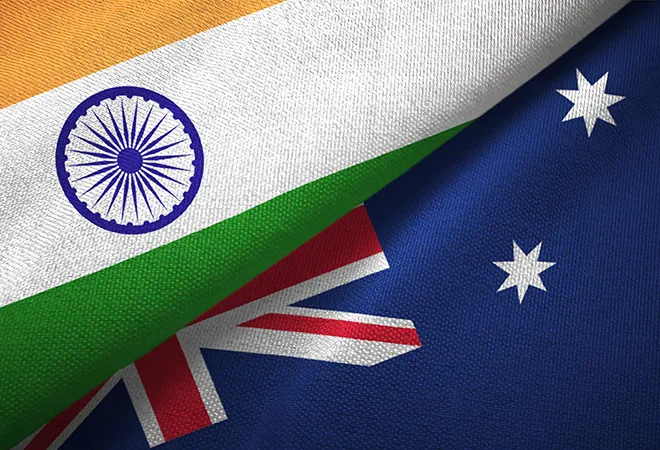
The Australia–India bilateral story is changing by the day. The engagement on both sides has amplified across multiple platforms and sectors, clearly focused on building tangible commitments and actions, to embrace a win-win partnership. If 2020 was the year of elevation of Australia–India bilateral ties to a Comprehensive Strategic Partnership (CSP), 2021 was about bringing pace, energy, and solidifying the bilateral economic engagement, 2022 is surely about a focused head start to script a new and committed engagement narrative, and the month of February had been a busy and promising month for bilateral ties.
The Quad agreed to accelerate the delivery of COVID-19 vaccines across the region, address regional challenges including humanitarian assistance and disaster response (HADR), maritime security, counterterrorism, countering disinformation and cyber security.
The dynamic global geostrategic and geoeconomic landscape is intensifying competition and redefining power, principles, and values on which the regional order should be based. The apparent barriers of the pandemic have created a new kind of catalyst for greater connectivity, cooperation, and co-existence. The vast Indo-Pacific region that comprises at least "38 countries, share 44 percent of world surface area, is home to more than 64 percent of the world’s population, accounts for 62 percen of global GDP with more than 50 percent of global trade traversing through its waters, highly heterogeneous with countries at different levels of development, all connected by a common thread of ‘the ocean’, is emerging as the new pivot to power." Australia welcomed India’s Minister for External Affairs, Dr S Jaishankar, for the Quadrilateral Security Dialogue (Quad) along with other group members, Japan and the USA, reiterating their support for a free and open Indo-Pacific. The Quad agreed to "accelerate the delivery of COVID-19 vaccines across the region, address regional challenges including humanitarian assistance and disaster response (HADR), maritime security, counterterrorism, countering disinformation and cyber security." Australia has also proposed to host an Indo-Pacific Clean Energy Supply Chain Forum in mid-2022.
Continuing the Indo-Pacific economic integration, also asks for establishing greater physical infrastructure and connectivity between South and Southeast Asia. “Australia will provide AUD$36.5 million over five years, including AUD $11.4 million to improve regional cooperation on maritime shipping, disaster resilience, and information sharing. It will invest AUD$10.2 million to increase engagement on regional economic challenges and explore new opportunities in the digital sector in Bangladesh. In addition, the Australian government will invest AUD$5.8 million to promote infrastructure investment opportunities in the region to Australian business, invest AUD$4.8 million to improve Australian resources and mining equipment, technology and services (METS), and understanding of South Asian markets. A further AUD$4.3 million will support relationships across the LNG supply chain between Australia, India, and Bangladesh. Together, these measures will support opportunities for trade, investment, and connectivity in the Northeast Indian Ocean. The evolving narrative on the Indo-Pacific region reflects the emerging structural shift in geostrategic and geoeconomic imagination and environment.
The Australian government will invest AUD$5.8 million to promote infrastructure investment opportunities in the region to Australian business, invest AUD$4.8 million to improve Australian resources and mining equipment, technology and services (METS), and understanding of South Asian markets.
With the advent of industry 4.0, cyber security, innovation, digital economy, and cyber & critical technology cooperation have become a key part of Australia’s relationship with India, enabling an ecosystem of collaboration between industry, academia, and subject matter experts through the New Centre of Excellence for Critical and Emerging Technology Policy to build security standards, best practices, and ethical framework. The inaugural Australia–India Foreign minister’s Cyber Dialogue focused on further promoting stronger investment opportunities and cutting-edge innovation in cyber, critical, and emerging technologies.
Foreign minister Dr S Jaishankar’s visit to Australia coincided with Australian Trade Minister Dan Tehan’s visit to India to advance the ongoing bilateral Free Trade Agreement negotiations, also called the Comprehensive Economic Cooperation Agreement (CECA), with a likely possibility of a full-fledged CECA becoming a reality sooner than later, considering the Australian federal elections are just around the corner. The economic context within which the CECA is being negotiated has changed, it is a completely different world to two years ago, and the ways in which crisis of supply, people and resourcing has manifested itself in business needs to be examined thoroughly. The CECA is likely to lower tariffs and provide greater access to Australian and Indian exporters in areas such as textiles, pharmaceuticals, footwear, dairy products, milk, premium wines and many more, focused on post-COVID economic recovery, along with the importance of an early resolution of ongoing issue of taxation of offshore income of Indian firms in Australia. A matter that was also highlighted during Minister Tehan’s meeting with India’s Finance Minister Nirmala Sitharaman. India’s attempt to revive trade talks with Australia, as well as the EU, UK, and US, and its signing of Free Trade Agreement with UAE, eyeing USD$100 billion trade in the next five years, emphasises its willingness to keep itself open to global trade—that will determine the degree to which it can attract investments, drive exports, make domestic industries competitive and incentivise other countries to manufacture in India. India aims to achieve 5 percent share in world merchandise exports and 7 percent in services exports by 2025, which currently stands at 1.67 percent in global merchandise exports, and 3.54 percent in services.
During Minister Tehan’s visit, both countries have also renewed their commitment through an MoU on Tourism Cooperation, enabling tourism operators on both sides to take advantage of Australia’s international border re-opening to all fully vaccinated eligible visa holders, including tourists and business travellers. “The MoU will promote travel between the two markets and advance cooperation on tourism policy, data sharing, training, and industry engagement. Pre-pandemic, India was Australia’s fastest-growing source of international visitors. In 2019, almost 400,000 visitors from India visited Australia and spent a combined total of US $1.8 billion.” A large Australian Indian diaspora population and international student cohort with accessible connectivity will continue to open up international travel to a larger proportion of India's population, also a strong enabler in building ‘Brand Australia’ in India. Further improving cultural literacy and perceptions of each other, from a broader bilateral economic relationship perspective.
The CECA is likely to lower tariffs and provide greater access to Australian and Indian exporters in areas such as textiles, pharmaceuticals, footwear, dairy products, milk, premium wines and many more, focused on post-COVID economic recovery, along with the importance of an early resolution of ongoing issue of taxation of offshore income of Indian firms in Australia.
Australia and India have also launched the Australia–India Infrastructure Forum, that will serve as a hub to promote two-way investment in infrastructure and support broader trade and investment bilateral objectives. Opportunities in urban infrastructure, transport, and water remain key focus sub-sectors for Australia in India. Australia’s largest superannuation fund, Australian Super which has over US $200 billion of funds under management, has over a one and a half billion dollars currently invested in India. With large sovereign funds, pension funds, private equity investing in India, and with infrastructure spend slated to be US$ 1.4 trillion by 2025 as part of the Govt. of India national infrastructure pipeline, opportunities are tremendous within the infrastructure sector to align mutual capabilities.
Social and cultural trends are fast-changing, and it is important to understand, reflect, and integrate with these changes. To foster the Australia-India community cooperation, creativity, understanding and exchange, Australia has also launched three Maitri (friendship) initiatives with a total investment worth AUD$20.8 million. “The AUD$11.2 million Maitri Scholarships Programme aims to attract and support high achieving Indian students to study in Australian universities particularly in science, technology, engineering, mathematics, and health. The AUD$3.5 million Maitri Grants and Fellowships Programme will build links between future leaders, supporting mid-career Australian and Indian professionals to collaborate on strategic research and shared priorities. The AUD$6.1 million Australia-India Maitri Cultural Partnership will boost the role of creative industries in economic and people-to-people ties to promote artistic talent and cultural exchanges in visual and performing arts, literature, film, television, and music industries.” ‘People’ are at the centre of this bilateral relationship, and exchanges provide a natural advantage of advisory and advocacy by building stronger cultural understanding/intelligence and establishing transnational networks that can be utilised in a big way. Strategic investment in stronger human capital to build new capabilities and to grasp how the levers of power and institutions work is an encouraging step for the bilateral growth story.
The bilateral intent is part of Australia’s Technology Investment Roadmap and its AUD$565.8 million commitment to support new international partnerships that make low emissions technologies a cheaper priority.
In the fourth Australia India Energy dialogue, both countries have decided to drive down the costs of technologies that will help reduce global emissions, with focus on tangible actions and projects including the manufacture and deployment of ultra-low-cost solar and green hydrogen. The initiative is part of Australia’s Technology Investment Roadmap where it has committed to support new international partnerships (AUD$565.8 million) and India is the sixth bilateral low emissions technology partnership for Australia, after Germany, Singapore, Japan, the Republic of Korea and the United Kingdom. Over 90% of solar cells globally use Australian technology. India in the next 10 years, will be one of the largest adopters of solar technology in the world and Australian and Indian innovators have significant potential to work together in this area. India’s National Hydrogen Mission could align well with Australia's advanced technology in the hydrogen industry, as well as with India’s emphatic push on green transition in Union Budget 2022.
The partnership between Australia and India is no longer one-dimensional or single layered, what we are witnessing today is a truly comprehensive bilateral growth story that is driven by consistency, commitment, and action. The key is to keep the Australia story thriving in India, and India story thriving in Australia on a consistent basis in public memory; this involves a holistic multi-stakeholder strategy and approach which deepens understanding and appreciation of each other.
The views expressed above belong to the author(s). ORF research and analyses now available on Telegram! Click here to access our curated content — blogs, longforms and interviews.




 PREV
PREV


